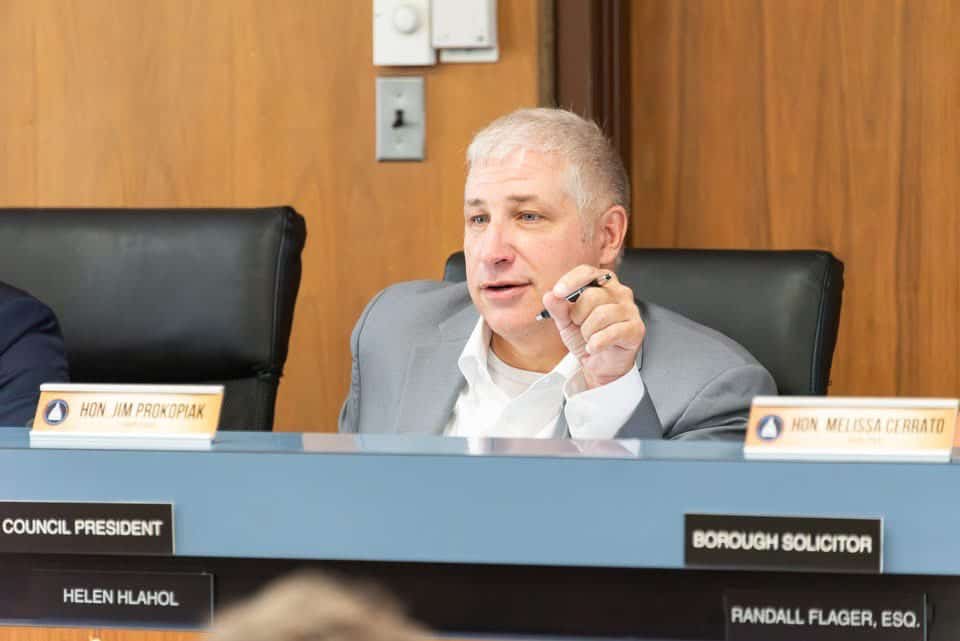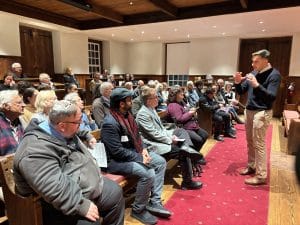Realtor Anne Costello, a speaker at the House Democratic Policy Committee Roundtable in Morrisville earlier this week, summed up the Commonwealth’s housing crisis saying, “A common myth is that housing is only out of reach for people in poverty.”
The House Majority Policy Committee hearing in Morrisville on Tuesday, convened by state Rep. Jim Prokopiak and attended by 11 of his House Democratic colleagues – including fellow Bucks County state Rep. Tim Brennan – featured housing experts from across the spectrum to examine the housing crisis.
With the exception of Mo Rushdy – who lives in New Jersey but serves as the president of the Building Industry Association of Pennsylvania – each of the experts on Prokopiak’s panel hailed from Bucks County.
“These communities in Bucks County were built for working-class people, and for decades it stayed that way. But since 2017, rent has gone up in our region by 50 percent,” said Prokopiak. “It affects our police departments, our schools and our entire community. We need to find ways to lower the cost of housing and make the American dream more attainable for everyone.”
The major take-aways from the half day session? There isn’t enough housing in Pennsylvania, and what housing there is is out of reach – especially in Bucks County.
Correne Kristiansen, Advocacy Coordinator at the Bucks-Mont Collaborative, a nonprofit membership organization of more than 130 service providers that assisted hundreds of thousands of individuals in the two counties – just last year – sounded a dire alarm.
Kristiansen explained that a person must earn nearly $37 an hour, “about $77,000 a year to afford a modest two-bedroom apartment,” in Bucks County. “Many of the people our communities rely on – teachers, first responders, home health aides, childcare providers, construction workers – typically earn far less.”
And what’s worse, as of 2023 statistics show that Pennsylvania isn’t doing much about the problem. Kristiansen cited a study that places the commonwealth at 44th in home construction, saying it “falls woefully behind in construction of new housing stock.”
“By investing in attainable housing now, Pennsylvania can reduce long-term expenditures and build stronger, healthier communities. Stable housing allows families to work, children to succeed in school, and local businesses to thrive, creating a stronger workforce and more resilient communities for decades to come,” said Kristiansen.
Dawn Diamond, president of Woods System of Care, spoke to the arduous process her organization endured when planning and building 42 units of workforce housing – more commonly referred to as attainable housing – in Middletown Township. Even though Woods System of Care already owned the land and had Pennsylvania Housing Authority administered federal funding, the process met with push back.
Diamond emphasized that Woods System of Care employs 1,600 people, all of whom need a place to live within commuting distance of their jobs. She added that many nurses earn far less than the median Bucks County household income of $112,000 per year and therefore cannot afford to live near their jobs.
Diamond recommended to the legislators that an education campaign is needed to combat the communities’ NIMBY (not in my back yard) sentiments when builders approach zoning boards for permits. She said that it is necessary to combat the “lack of knowledge, lack of zoning and lack of resources” that stand in the way of building projects.
Mo Rushdy echoed her sentiments. From his vantage point, working closely with the Philadelphia Mayor’s office and developing hundreds of new available homes for working people in that city – citizens and their representatives need to better embrace the concept of affordable housing.
Rushdy’s stated goal of providing housing for people with moderate incomes, those in the $20 an hour range, took pointed aim at zoning regulations that are heaped on developers of lower income based housing. He emphasized that persons making $45,000 a year don’t qualify for subsidized housing through HUD or other federal programs, but they also don’t make enough to afford housing anywhere in the commonwealth.
Rushdy explained, “Restrictive zoning laws and prolonged permitting processes are major barriers.” He said that years of process drive costs up.
The assembled roundtable nodded in agreement when he cited some of the changes to zoning requirements that would help the most – but likely receive push back in some of Bucks County’s more affluent communities.

Among these solutions were “allowing duplexes and triplexes in single family zones, reducing minimum lot sizes, creating high-density zoning designations and public transit,” as well as “eliminating excessive parking requirements.”
In short, Rushdy called for executive leadership that would restrict, “Communities ability to tie up projects in litigation.”
Rep. Prokopiak doesn’t wield executive power, but he has proposed legislation he believes will ease the zoning woes perpetuating the housing shortage. Prokopiak’s HB 529, Establishing the Smart Growth Zoning and Housing Program and the Smart Growth Zoning District Fund, would direct municipalities across the state to streamline areas for growth “by trying to incentivize, to remove obstacles, to allow the builders in the private market to move forward with these projects at a quicker pace.”
Prokopiak referred to Diamond’s testimony, adding, “When we talk about Wood Services, they’ve been working on this same project for five years. You know, costs have gone up substantially in five years. It impacts everybody.”
It’s that everybody that brought Costello to the table. She’s concerned that her community has lost track of how many moderate-income individuals it takes to make society run smoothly.
And while the realtor’s selling houses, she knows that firefighters, nurses and other first responders can’t afford to buy homes near the people they serve. “We are talking about communities. Investing in our communities.”
Following the prepared remarks by those invited to testify, the discussion was opened between testifiers and the PA representatives.
One after another, the elected officials voiced agreement with the comments made by the experts before them. Delaware County Rep. Gina Curry voiced concern for the small landlords. She shared first-hand knowledge of a man who had to live in his truck when a corporate holding company bought his building and raised the rent. “Mom and pop landlords are being pushed out of the area.”
Several of the representatives still have adult children living at home.
Rep. Heather Boyd, also of Delaware County, mentioned interest rates – emphasizing how unlikely it was that anyone who bought their homes earlier in the decade, with a two or three percent interest rate, would sell.
Boyd remarked, “I have a 50/50 split in my district – homeowner to renter community.” She said that people who bought starter homes are staying put, proffering the mentality, “We’ll borrow against the increased value of our houses” for upgrades or other needs.
Montgomery County’s Rep. Melissa Cerrato concurred, commenting on how much the value of her home had increased. “I couldn’t afford to buy my own house, now.”
As the session neared its conclusion, Kristiansen retrained focus on the plight of those too financially insecure to even dream about homeownership. Harkening back to an example she had given earlier in her testimony – of an 81-year-old woman trying to raise her grandchildren and looking for a part-time job to pay the rent – she emphasized the worsening situation for the elderly in Bucks County and beyond.
And then there’s the problem of housing the working poor. HUD’s (U.S. Department of Housing and Urban Development) Section 8 program is being cut or limited to two years eligibility. U.S. Senate Republicans have proposed a federal budget that eliminates the type of tax credits that made the Wood Services project possible.
Kristiansen lamented how unaware some residents are – that the people needing housing are the people healthy communities need to exist. “They are going to go to the hospital and there’ll be no nurses’ aides. They’ll call 911 and the police will be understaffed.”
What may be even more alarming is the possibility of losing even more ground. Millions of dollars funneled into the Bucks County Housing Authority to support thousands of units for families making less than 50 percent of the county’s median income could vanish over the next few years.
READ: Nearly 1 in 3 Families with Children in Bucks County Are Struggling Economically, Says New Report
Following Rep. Prokopiak’s hearing, Bucks County Beacon asked him whether seeking remedies would be more difficult with so many partisan cuts coming down from the federal government.
Prokopiak replied, “This is an issue for everyone, you know, putting a roof over your head is not a Democratic a Republican issue. It’s a human issue. It’s a community issue.”
Prokopiak concluded that as representatives it was their job to assure that “everyone who works hard has the ability to put a roof over their head and move forward with their American dream.”
He cautioned his colleagues against making that more difficult for constituents. “We are making that harder today, and we need to make it easier. For those people who are against this type of stuff, then, you know, they’re going to have to face their own voters.”







